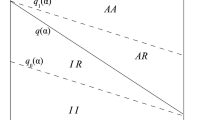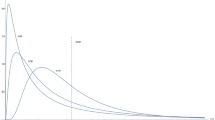Abstract
This paper offers an interpretation of the precautionary principle in terms of a safety target that a decision-maker has to reach at a minimal cost in a robust way. A two-period model is used. The precautionary principle corresponds to a situation in which the decision-maker, facing an ex ante indecision, is not able to reach a safe target from the initial condition in a worst-case framework. However, he can efficiently succeed whenever the uncertainty at the second period is revealed to him. An example coping with the management of a renewable resource illustrates the general results of the paper.
Similar content being viewed by others
Notes
Similarly, the usual information value is basically related to the difference between E w (min u g(u,w)) and min u E w (g(u,w)) in a probabilistic framework. We recover here the same kind of difference through a minimax inequality
$$\sup_{w\in {\mathbb W}}\inf_{u\in {\mathbb U}}g(u,w)< \inf_{u\in {\mathbb U}}\sup_{w\in {\mathbb W}}g(u,w).$$Conditions for the equality to hold true can be found in [2] for instance.
Typically, we might assume that R + > 1 and R − < 1, illustrating the fact that, for uncertain population dynamics, both decreases and increases of abundance can occur.
References
Bertsekas, D. P., & Shreve, S. E. (1996). Stochastic optimal control: The discrete-time case. Belmont: Athena Scientific.
Bertsekas, D. P., Nedic, A., & Asuman E. (2003). Convex analysis and optimization. Belmont: Athena Scientific.
Freeman, R. A., & Kokotovic P. V. (1996). Robust nonlinear control design: State-space and Lyapunov techniques. Heidelberg: Springer.
Gilboa, I., & Schmeidler, D. (1989). Maxmin expected utility with non unique prior. Journal of Mathematical Economics, 18, 141–153.
Golier C., Jullien, B., & Treich, N. (2000). Scientific progress and irreversibility: An economic interpretation of the precautionary principle. Journal of Public Economics, 75, 229–253.
Graham, J. D. (2001). Decision-analytic refinements of the precautionary principle. Journal of Risk Research, 4(2), 127–141.
Hansen, L. P., Maenhout, P., Rustichini, A., Sargent, T. J., & Siniscalchi, M. M. (2006). Introduction to model uncertainty and robustness. Journal of Economic Theory, 128, 1–3.
ICES (2005). Report of the ICES advisory committee on fishery management, advisory committee on the marine environment and advisory committee on ecosystems. ICES Advice. Volumes 1–11. 1, 418 pp.
Lauck, T., Clark, C. W., Mangel, M., & Munro, G. R. (1998). Implementing the precautionary principle in fisheries management through marine reserves. Ecological Applications, 8(1), Supplement:S72–S78.
Olson, L. J., & Roy, S. (2000). Dynamic efficiency of conservation of renewable resources under uncertainty. Journal of Economic Theory, 95, 186–214.
O’Riordan, T., & Cameron, J. (1994). Interpreting the precautionary principle. London: Earthscan.
Sandin, P. (1999). Dimensions of the precautionary principle. Human and Ecological Risk Assessment, 5, 889–907.
Author information
Authors and Affiliations
Corresponding author
Rights and permissions
About this article
Cite this article
Doyen, L., Pereau, JC. The Precautionary Principle as a Robust Cost-Effectiveness Problem. Environ Model Assess 14, 127–133 (2009). https://doi.org/10.1007/s10666-008-9153-7
Received:
Accepted:
Published:
Issue Date:
DOI: https://doi.org/10.1007/s10666-008-9153-7




